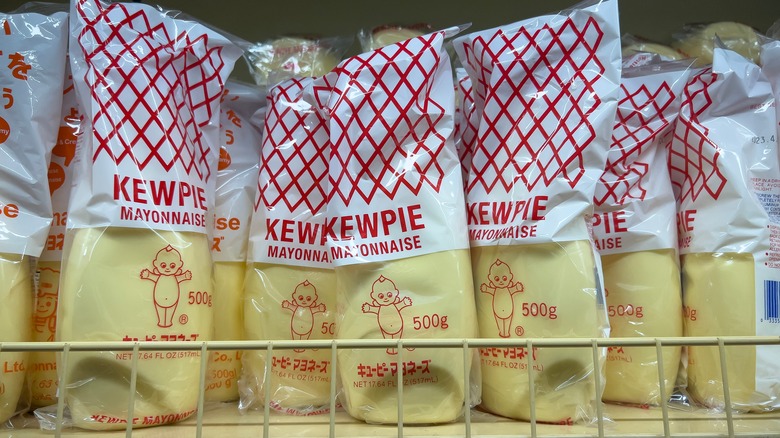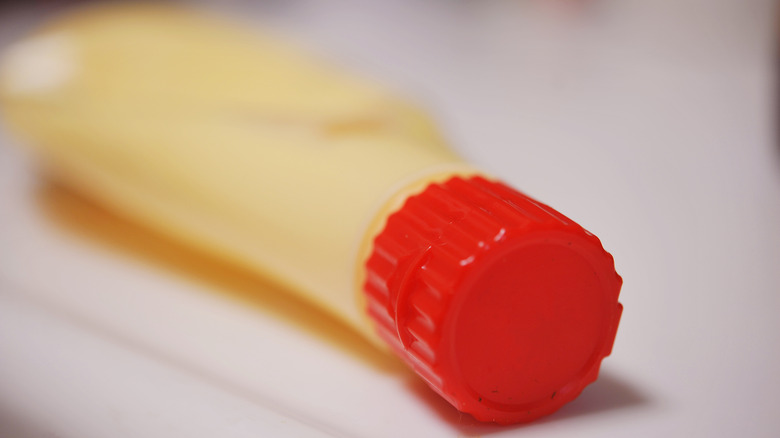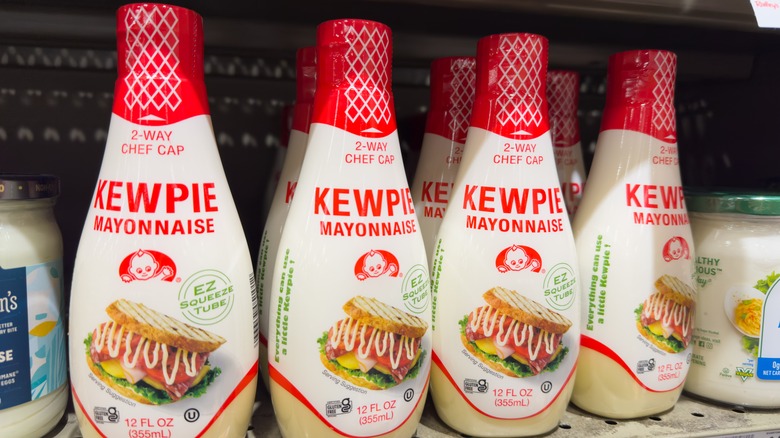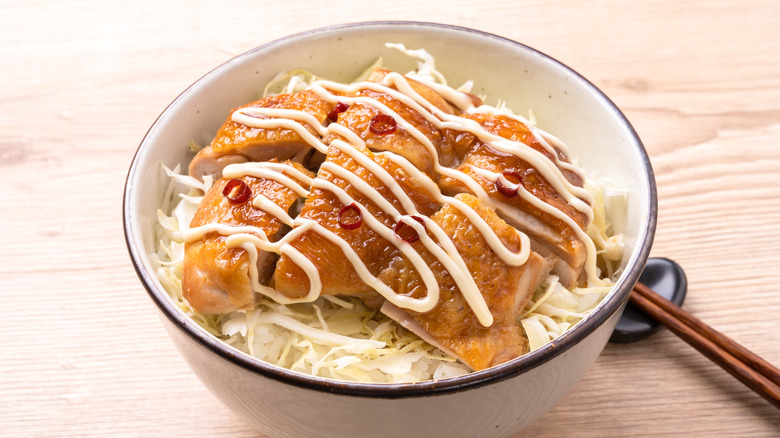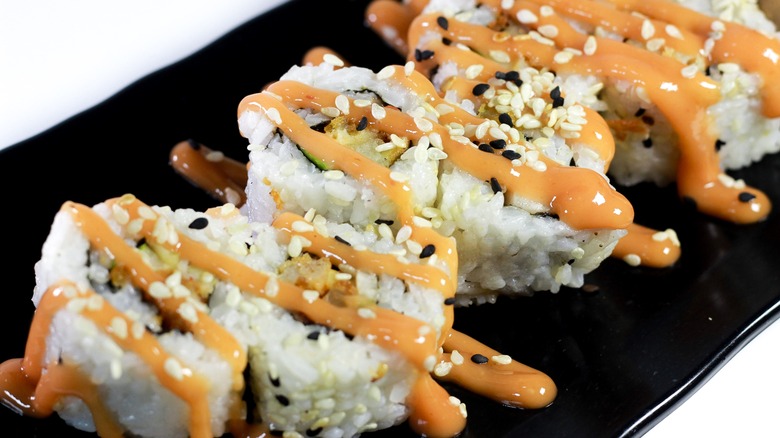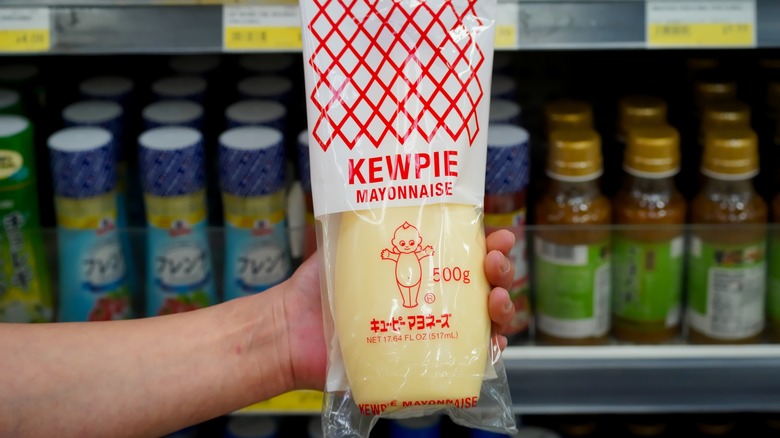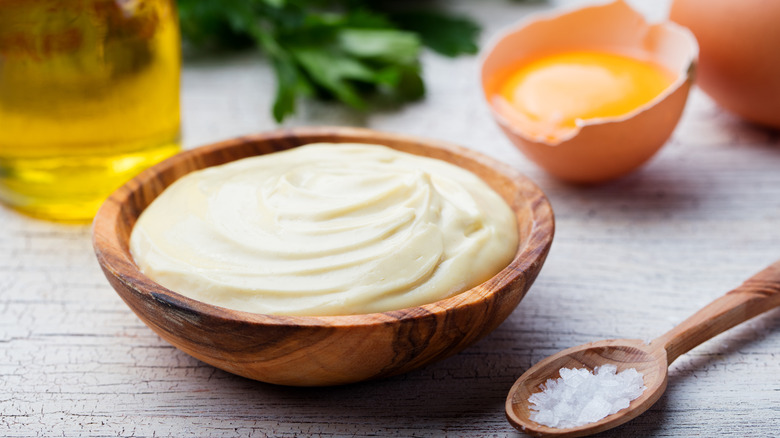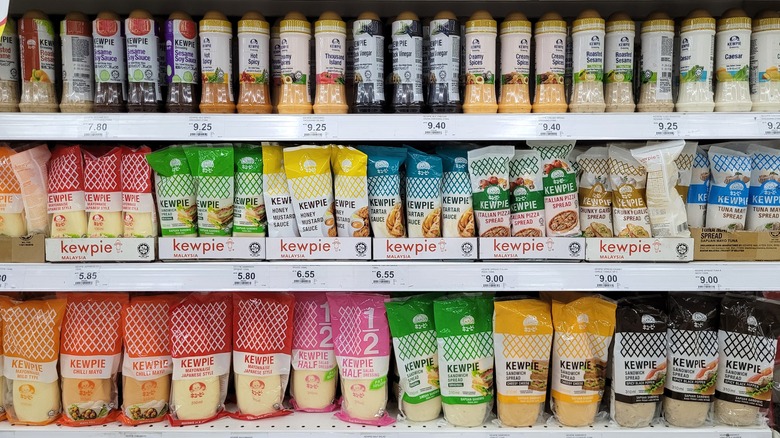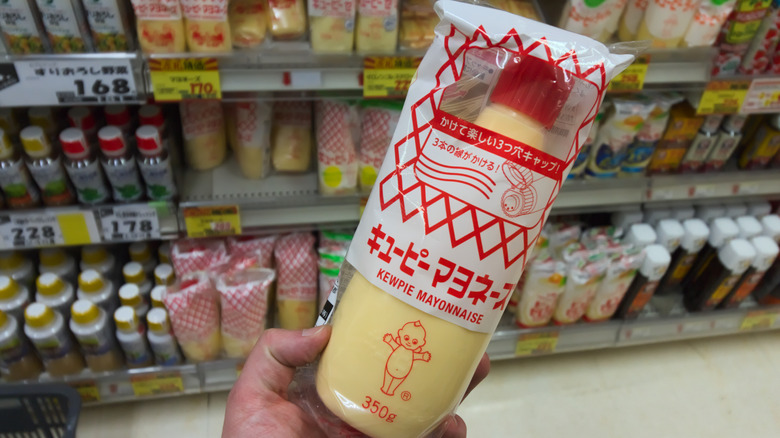What Is Kewpie Mayo And Why Do Chefs Say It's The Best?
Ask any foodie who keeps up with the latest culinary trends and they may tell you about Kewpie mayo. This popular mayonnaise is used in a number of dishes in Japan, mostly notably egg salad sandwiches sold at 7-Eleven. While the company has been around for almost a century, it was only in the 1980's when Kewpie opened its first manufacturing plant in the U.S. Since then, the company has expanded to North America, Europe, as well as other Asian countries. But what makes this mayo so great that it's crossed borders and become a worldwide phenomenon? Aside from its myriad of flavors and choices, the popularity of Japanese food in general may have something to do with pop culture trends, including manga and anime, stirring up interest in other aspects of life in Japan. Japanese food also has a reputation for being healthy. Regardless of the reason, many are impressed by Kewpie mayo's creamy texture and flavorful taste.
To find out more about Kewpie mayo's popularity, we spoke with two experts, YouTuber Sam Zien, known as Sam the Cooking Guy, and David Schuttenberg, acclaimed chef and co-owner of Asian restaurant Beautiful South in Charleston, SC, to get their takes on why Kewpie is the best mayo you'll ever taste.
What is Kewpie mayo?
For many fans around the world, Kewpie stands out because of its rich taste and light, creamy texture, coupled by its easy-to-recognize packaging, a signature clear squeeze bottle with red latticework and a Kewpie doll outlined in red serving as mascot. Bottles of original recipe Kewpie mayo often come in a clear plastic bag printed with the same red lattice pattern.
A relatively recent discovery in the U.S., Kewpie mayo's history goes back to the 1910s when its founder, Toichiro Nakashima, interned at what was then known as Japan's Department of Agriculture and Commerce. His internship took him to the U.K and the U.S., where he discovered mayonnaise and was inspired to create a product that would be considered healthy. He launched Kewpie Mayonnaise in 1925, a product that contains twice the amount of egg yolks found in other mayonnaise brands at the time. While this was intended to be more nutritious, it also made it incredibly tasty. Kewpie's decadent flavor comes down to the amino acids from the egg yolks. Today, Kewpie is the best-selling mayonnaise in Japan.
How is Kewpie mayo made?
Kewpie mayo generally contains three main ingredients: egg yolks, oil, and vinegar. However, the ingredients can vary slightly depending on the country it's sold in and may include spices and other natural flavors. In Japan, for example, Kewpie mayo contains MSG, while Kewpie in the U.S. contains a yeast extract. And in Europe, Kewpie mayo contains a variety of vinegars along with rapeseed oil.
Once all the ingredients are inspected for quality control, the eggs go through a special egg cracking machine, and are then pasteurized and blended together. Once the product is bottled, its cap is sealed in tightly, the air replaced with nitrogen to preserve the mayonnaise's freshness and flavor. Through the years, Kewpie has inspired other brands to make similar products. Today, these are collectively called "Japanese mayo." You can even make your own version of Kewpie mayo at home. The key is to make an emulsion, which involves slowly pouring the oil into the eggs, stirring quickly to blend them.
Kewpie mayo vs. other kinds of mayo
Kewpie mayo has a reputation for being delicious and savory, but does it really stand out among other mayos? How does Kewpie compare, say, to popular brands like Hellmann's and Duke's? For Sam Zien, there's no question that Kewpie mayo is something special. Since trying it years ago, he says, "There really aren't other kinds of mayo for me anymore." He praises Kewpie mayo for being "way smoother and creamier, a little tangier, a teeny bit eggier" than any other brand on the market.
David Schuttenberg agrees with Zien. When asked about how Kewpie mayo compares to other kinds of mayonnaise, he jokes, "There are other kinds?" For Schuttenberg, Kewpie mayo is "creamier, eggier, umami-er," adding that it has a "cuter delivery device," referring to Kewpie bottles' lettering and designs, as well as its retro-looking Kewpie figure mascot and star-shaped nozzle. Overall, Kewpie wins the condiment game amongst many foodies.
What does Kewpie mayo taste like?
Kewpie Corporation proudly states on its website that Kewpie "Tastes like no other mayonnaise!" and fans would agree. But when Kewpie aficionados talk about their favorite mayo, they don't just mention its tangy, creamy savoriness. The mayonnaise's unique texture is also part of its appeal. David Schuttenberg explains that Kewpie is emulsified into "a perfectly creamy, tight sauce" while other brands tend to be over emulsified, which results in a "gloopy, overly thick consistency."
Sam Zien echoes this sentiment. A longtime Kewpie fan, Zien explains that Kewpie mayo "has a great mouth feel (which I always feel creepy saying, but it's true — just like how Fiji water feels different than other waters)," adding that you can "see the difference." Other food bloggers, including The Fork Bite, are also enthusiastic about Kewpie mayo, claiming that it's both acidic and sweet, and sets the standard for other mayonnaise brands to follow.
How to make food with Kewpie mayo
For Sam Zien, Kewpie mayo "can become an ingredient that stands on its own in a dish." He also adds, "You use it and it just becomes part of whatever you're making." For instance, Kewpie can be mixed with with Sriracha to make spicy mayo for sushi. The possibilities are endless. As for David Schuttenberg, he says, "I use it on the outside of my grilled cheese sandwiches in place of butter to crisp my bread. It gives my sandwich that extra oomph." The chef's favorite way to use Kewpie is by adding it to his restaurant Beautiful South's chili crisp. "I whisk in some Kewpie to make a 'comeback sauce' from the gods," says Schuttenberg. "There isn't a better sauce for peel and eat shrimp."
In one of Zien's recent videos on YouTube, he presented 10 different recipes that involved using Kewpie mayo, including a spicy grilled shrimp and 3-ingredient biscuits. Zien also recommends adding Kewpie mayo to mashed potatoes, roasted potatoes, and even scrambled eggs. Additional recipes can found on Zien's website, as well as on Kewpie's website.
Where to buy Kewpie mayo
Kewpie mayo is typically sold at your local grocery store, an Asian supermarket, Target, Walmart, or Costco. You can also buy Kewpie mayo online, either via Kewpie's official shop or retailers such Amazon. Some fans prefer the original Kewpie mayo with MSG but the U.S.'s version does not contain this ingredient. Sam Zien tells Chowhound, "I'm a fan of both [versions], but prefer the OG from Japan," adding that it gives it "a little something extra." The original version with MSG is usually packaged in a plastic bag or has a simple red latticework design. Always check the label before you buy.
You can purchase Kewpie mayo with or without MSG on Amazon, with prices currently at $11.74 for two 17.64-ounce bottles of the original version, and $14.99 for two 12-ounce bottles of the MSG-free version. At Walmart, a single 17.64 fl oz bottle of original Kewpie mayo is now $5.87 and a 12-ounce bottle of MSG-free Kewpie mayo for $9.99. And at Target it's $4.99 for a 12 fl oz bottle of MSG-free mayo or $6.29 for a 17.64 fl oz bottle of the original version.
Nutritional information about Kewpie Mayo
The original version of Kewpie mayo contains no artificial preservatives and is low in sodium. The brand has also adapted to different consumer needs. For instance, Kewpie mayo produced for the U.S. market is gluten-free. However, both Japan and the U.S.'s version of Kewpie contains mustard. But allergy concerns aside, Sam Zien notes that it's not always the healthiest option. "Mayo is essentially just fat," he says, "so why not use the best tasting one out there?"
Classic Kewpie mayo has one ingredient that many people find controversial: monosodium glutamate, or MSG. MSG is essentially salt added to glutamate, an amino acid found in edible substances as diverse as tomatoes and breast milk. MSG was discovered by a University of Tokyo chemistry professor named Kikunae Ikeda in 1908. The compound's ability to bring out foods' umami taste quickly made it popular in Japan and other Asian countries. But in 1968, a Chinese doctor living in the U.S. wrote a letter claiming that MSG caused symptoms like numbness and weakness whenever he ate at Chinese restaurants. The letter caused a panic and began the mistrust of MSG that still remains in countries like the U.S. to this day. Since then, scientists have found that the symptoms are largely a placebo effect, and MSG is safe to consume in a meal. If you're still wary about MSG, Kewpie has replaced it with yeast and other substances for the U.S. and European markets.
Varieties of Kewpie mayo
In addition to the brand's sauces and dressings, there are several varieties of Kewpie mayo, depending on the market, including a vegan version. Kewpie mayo for the European market is MSG-free, too, and does contain some additional flavorings, designed to be as close to the original's taste as possible. The Chinese market's version, on the other hand, is a bit sweeter.
Aside from variations on its original recipe, Kewpie makes flavored mayos. However, those are only available in certain markets. If you're lucky enough to travel to Thailand, for instance, you can try wasabi, Sriracha, or truffle Kewpie mayo. Kewpie fans in Australia can try Kewpie Yuzu, the classic recipe flavored with yuzu fruit. Of course, there are a number of Kewpie flavors available in the Kewpie Corporation's home country of Japan. One of them, Kewpie Smoke, is Sam Zien's favorite. It's difficult to find in the U.S, but a must-try. He describes the taste as "delicious Kewpie, with a hint of smoke — not overdone at all." But don't give up hope: If you're craving some of these Kewpie flavors, you may be able to find them through online retailers.
How to store Kewpie mayo
Kewpie mayo's squeeze bottle design is what helps preserve it longer. And while classic Kewpie mayo contains no chemical preservatives, two of its ingredients — rice vinegar and MSG — work as natural ones. Most kinds of Kewpie mayo have a shelf life of 12 months if unopened, although this may vary, so always check the label. No matter what kind it is, Kewpie mayo should be refrigerated after opening just like any mayonnaise.
Many versions of Kewpie mayo come with what the company calls "multi-layered plastic" in order to keep oxygen out. On her blog, writer and Kewpie mayo fan Yangsze Choo sums it up: "the bottle itself seems to be a perfectly adequate container, but that's just the way it is." So if you don't want to keep all of that packaging, you can throw the bag away (or better yet, recycle or repurpose it) once you've opened the bottle.
How Kewpie mayo and Kewpie dolls are connected
Now that you know so much about Kewpie mayo, you may still be wondering: Why Kewpie? The cupid-like Kewpie character was created by American illustrator Rose O'Neill in 1909. It was patented in 1913 and slowly gained in popularity. It's unclear why Kewpie Corporation founder Toichiro Nakashima chose the doll as the namesake for his company, but presumably, it was due to the doll's popularity at the time. Some blogs, such as Miffa Chan, have theorized that the Kewpie doll may be associated with traditional Japanese values and their level of cuteness.
In 1927, the connection between Kewpie dolls and Kewpie mayonnaise got deeper. The Kewpie Corporation bought the rights to produce the doll in Japan and other Asian countries. Today, you can get both your Kewpie mayo and Kewpie doll fix at Mayo Terrace, the Kewpie Corporation's museum in Tokyo, one of the many untold truths about Kewpie, where you can learn about Kewpie's history and its ingredients, all while touring the facility and sampling its goods.
